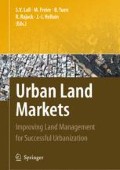Abstract
Developing countries, unlike most developed ones, may have a large informal housing sector that exists outside the formal sector and outside direct regulation. At the extreme it may involve squatter settlements on invasions of land that originally might have been owned by the government or subject to title dispute. However, it may also involve illegal developments of private land, where the houses constructed do not meet regulatory standards and the properties sold may offer limited property rights over the housing and none over the land. The government may be politically unable to shut down the informal sector, and poor institutions may leave significant portions of urban land without proper title. While the informal sector avoids direct land use regulation, the local government may attempt to indirectly regulate the scope of its development by not providing it with certain public infrastructure services (such as connections to general road, water, and sewerage systems) or by threatening the tenure security of residents.
Access this chapter
Tax calculation will be finalised at checkout
Purchases are for personal use only
Preview
Unable to display preview. Download preview PDF.
References
Antwi, A. Y., & Adams, J. (2003). Rent-seeking behaviour and its economic costs in urban land transactions in Accra, Ghana. Urban Studies, 40(10), 2083–2098.
Avila, P. C. (2006). Land use regulations in Brazil : Impacts on urban markets and access of lowincome people to land and housing. Paper prepared for Lincoln Institute of Land Policy, Cambridge, MA.
Bertaud, A., & Brueckner, J. (2005). Analyzing building-height restrictions: Predicted impacts and welfare costs. Regional Science and Urban Economics, 35(2), 109–125.
Bertaud, A., & Malpezzi, S. (2001). Measuring the costs and benefits of urban land use regulation: A simple model with an application to Malaysia. Journal of Housing Economics, 10(3), 393–418.
da Mata, D., Deichmann, U., Henderson, J. V., Lall, S. V., & Wang, H. G. (2007). Determinants of city growth in Brazil. Journal of Urban Economics, 62(2), 252–272.
Davis, O. A., & Winston, A. B. (1964). The economics of complex systems: The case of municipal zoning. Kyklos, 17, 419–445.
Dowall, D. (2007). Brazil’s urban land and housing markets: How well are they working? In G. Ingram (Ed.), Land policies and their outcomes. Cambridge, MA: Lincoln Institute of Land Policy.
Epple, D., & Nechyba, T. (2004). Fiscal decentralization. In J. V. Henderson & J.-F. Thisse (Eds.), Handbook of regional and urban economics(Vol. 4, pp. 2423–2480). Amsterdam: North Holland.
Flatters, F., Henderson, J. V., & Mieszkowski, P. (1974). Public goods, efficiency, and regional fiscal equalization. Journal of Public Economics, 3(2), 99–122.
Glaeser, E. L., & Gyourko, J. (2003). The impact of zoning on housing affordability. Economic Policy Review, 9(2), 21–39.
Glaeser, E. L., Gyourko, J., & Saks, R. (2005a). Why have housing prices gone up? NBER Working Paper 11129. Cambridge, MA: National Bureau of Economic Research.
Glaeser, E. L., Gyourko, J., & Saks, R. (2005b). Why have housing prices gone up? American Economic Review, 95(2), 329–333.
Glaeser, E. L., Gyourko, J., & Saks, R. (2005c). Why is Manhattan so expensive? Regulation and the rise in housing prices. Journal of Law and Economics, 48(2), 331–370.
Glaeser, E. L., Gyourko, J., & Saks, R. (2006). Urban growth and housing supply. Journal of Economic Geography, 6(1), 71–89.
Gyourko, J., Mayer, C. J., & Sinai, T. (2006). Superstar cities. NBER Working Paper 12355. Cambridge, MA: National Bureau of Economic Research.
Helsley, R. W. (2004). Urban political economics. In J. V. Henderson & J.-F. Thisse (Eds.), Handbook of regional and urban economics(Vol. 4, pp. 2381–2422). Amsterdam: North Holland.
Kironde, J. M. L. (2005). The regulatory framework, unplanned development and urban poverty: Findings from Dar es Salaam, Tanzania. Land Use Policy, 23(4), 460–472.
Malpezzi, S. (1996). Housing prices, externalities, and regulation in U.S. metropolitan areas. Journal of Housing Research, 7(2), 209–241.
Malpezzi, S., & Mayo, S. K. (1997). Getting housing incentives right: A case study of the effects of regulation, taxes, and subsidies on housing supply in Malaysia. Land Economics, 73(3), 372–391.
Malpezzi, S., & Sa-Aadu, J. (1996). What have African housing policies wrought? Real Estate Economics, 24(2), 133–160.
Mayer, C. J., & Somerville, C. T. (2000). Land use regulation and new construction. Regional Science and Urban Economics, 30(6), 639–662.
Mayo, S., & Sheppard, S. (1996). Housing supply under rapid economic growth and varying regulatory stringency: An international comparison. Journal of Housing Economics, 5(3), 274–289.
Mills, E. S., & Oates, W. E. (Eds.). (1975). Fiscal zoning and land use controls. Lexington, MA: Lexington Books.
Pollakowski, H. O., & Wachter, S. M. (1990). The effects of land-use constraints on housing prices. Land Economics, 66(3), 315–324.
Quigley, J. M., & Raphael, S. (2005). Regulation and the high cost of housing in California. American Economic Review, 95(2), 323–329.
Sivam, A. (2002). Constraints affecting the efficiency of the urban residential land market in developing countries: A case study of India. Habitat International, 26(4), 523–537.
Wu, W. (2004). Sources of migrant housing disadvantage in urban China. Environment and Planning A, 36, 1285–1304.
Zhou, M., & Cai, G. (2008). Trapped in neglected corners of a booming metropolis: Residential patterns and marginalization of migrant workers in Guangzhou. In J. R. Logan (Ed.), Urban China in transition(pp. 226–249). Malden, MA: Blackwell.
Zhu, J. (2005). A transitional institution for the emerging land market in China. Urban Studies, 42(8), 1369–1390.
Author information
Authors and Affiliations
Editor information
Editors and Affiliations
Rights and permissions
Copyright information
© 2009 World Bank
About this chapter
Cite this chapter
Henderson, J.V. (2009). The Effect of Residential Land Market Regulations on Urban Welfare. In: Lall, S.V., Freire, M., Yuen, B., Rajack, R., Helluin, JJ. (eds) Urban Land Markets. Springer, Dordrecht. https://doi.org/10.1007/978-1-4020-8862-9_2
Download citation
DOI: https://doi.org/10.1007/978-1-4020-8862-9_2
Publisher Name: Springer, Dordrecht
Print ISBN: 978-1-4020-8861-2
Online ISBN: 978-1-4020-8862-9
eBook Packages: Earth and Environmental ScienceEarth and Environmental Science (R0)

